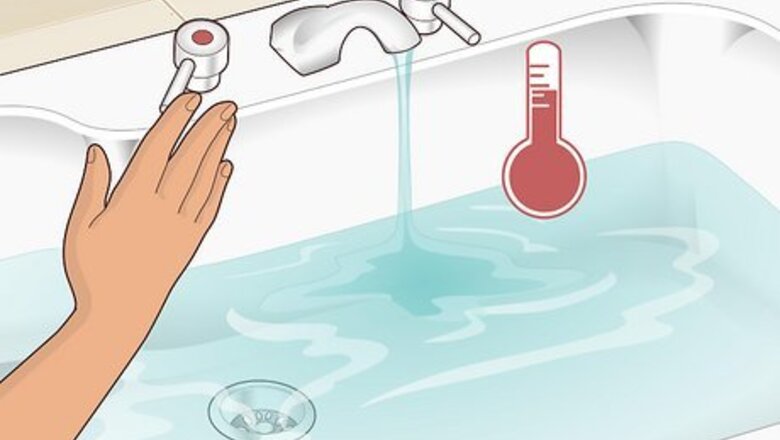
views
Hot Water Drip
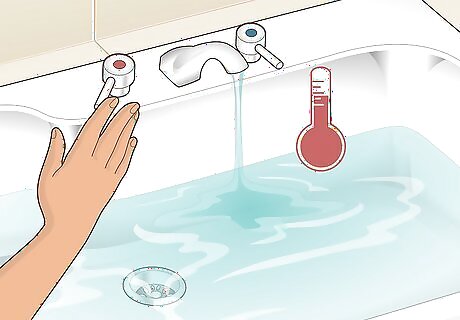
If the water is draining, let the hot water run to see if that fixes it. So long as the water isn’t going to overflow, turn the tap on to hottest setting and just let a steady trickle of water out. If it’s a minor blockage, the flow of hot water may break it up. If the hot water drip doesn’t break the clog up after 5-10 minutes, move on to another option.
Boiling Water
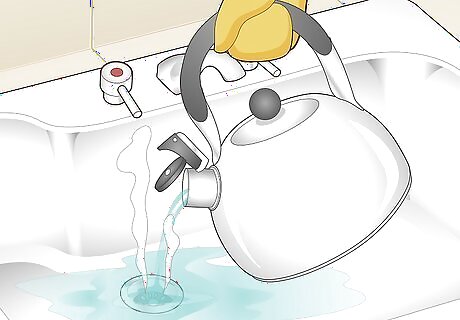
Boiling water should naturally break up most minor blockages. Fill a pot with tap water and heat it until it reaches a rolling boil. Put on some oven mitts and carry the pot over to the bathroom sink. Pour the water down the drain until you’ve filled the bowl of the sink. Wait for the water to drain and keep pouring until you’ve emptied the pot. This may break up any minor blockages. If you’re confident that grease is a culprit here, add a few squirts of dish soap to the boiling water before you pour it down the drain.
Plunger
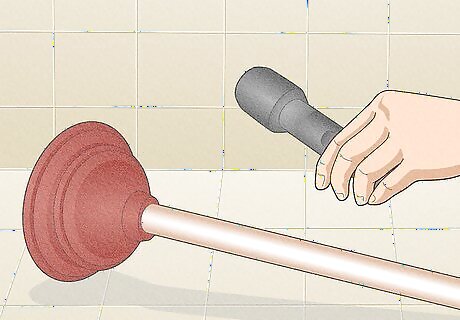
Use a plunger to force water down and break the blockage up. Grab a plunger and turn the hot water on until the sink is partially full with water. Before the water has a chance to drain, set the plunger over the drain stopper. Push repeatedly the same way you would if you were trying to unclog a toilet. Once you hear gurgling, the blockage is clear! Run the water to rinse out any blockage residue. If this doesn’t work, it’s a sign that no amount of water is going to help. You’ll probably need to break out something that will damage the blockage to remove it. If your sink is flat, use one of those simple plungers with a flat bottom (they’re usually black or orange). If the sink is especially round, use a toilet plunger with a flange at the bottom, which is designed to unclog the round holes in a toilet.
Baking Soda & Vinegar
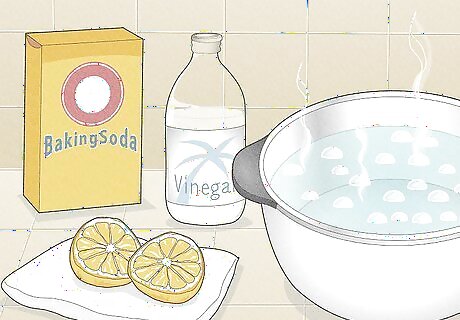
This fizzling and bubbling mixture should fix minor pipe clogs. Once the water has drained entirely, pop the drain stopper up as far as it will go or remove the stopper. Pour 1 cup (275 g) of baking soda down the drain. Then, slowly pour 1 cup (230 mL) of distilled white vinegar down the drain. Wait 15 minutes or so for the combo to fully fizz up, clean your pipes, and drain. Then, check your drain to see if the problem is resolved. Be careful with this option if you’ve got very old pipes. Baking soda and vinegar will expand inside the pipe, and if they’re especially old this could cause the pipes to leak or break. Try small amounts of vinegar and baking soda to test it out, first.
Drain Cleaner
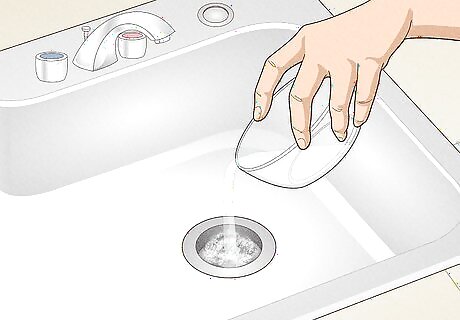
Grab any commercial drain cleaner and follow the instructions. Commercial drain cleaners, like Drano and Plumr, are certainly a step up in strength from baking soda and vinegar. If your drain is still clogged, break out a drain cleaner and follow the instructions on the label. You typically just pour some into the sink and wait. This may fix any stubborn blockages. Drain cleaners get a bad wrap because they’re caustic, which means they contain the spicy chemicals that aren’t great for humans. But if you just pour a little down the drain and crack a window, you’ll be fine.
Stopper Removal
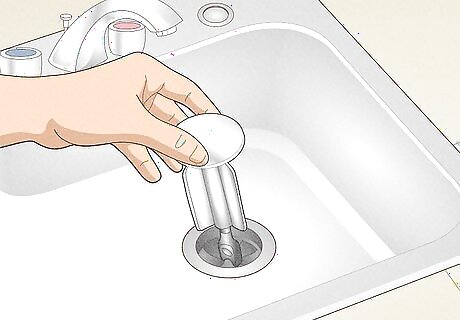
Bathroom sinks often clog because hair gets caught on the stopper. Look under your sink. Look at the back half of the sink’s underside where you pull that little plunger to close the drain. Follow that plunger rod down and locate the clamp connecting the stopper to the pipe. Undo this clamp. Then, pull up the sink stopper by hand. Remove any tangled hair by hand, rinse the stopper out, and wipe off any gunk on the underside of the stopper with dish soap and a rag. The stuff that gets caught on the drain stopper might be a little icky. Throw on some rubber gloves if there’s a ton of hair, grease, and debris sticking to the stopper.
Snake
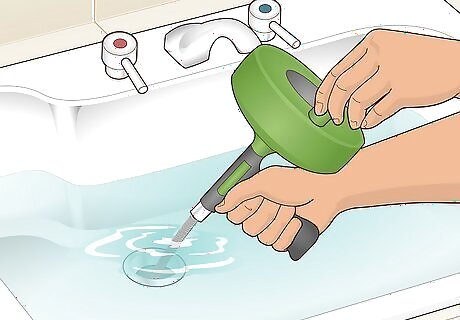
You can snake a bathroom sink the same way you snake a toilet. Purchase, rent, or borrow a drain auger (also known as a snake). Remove the sink stopper or pull it up high enough to feed the line down the drain. Then, pull the trigger or turn the handle on the auger to feed the line down the pipe. Continue feeding the line until you reach the blockage. Slowly force through the clump to break it up and remove the auger line. Directly under your sink drain there’s a round pipe call a P-trap. Go slow at the beginning so you don’t get stuck on that round pipe.
Zip-It Tool
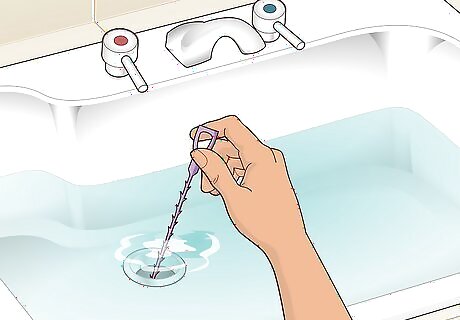
Zip-Its are cheap, plastic drain tools that will clear up minor blockages. A Zip-It is basically a thin strip of plastic with ridges on it. It works like a drain auger, but it’s simpler to use. Simply push the end of the strip into the drain and move the Zip-It back and forth. Pull the tool out, remove the gunk, and repeat the process until the blockage is clear. Zip-Its are quick and easy to use, but they may not reach deeper clogs. They also often require multiple uses to clear tougher blockages.
Wet-Dry Vac
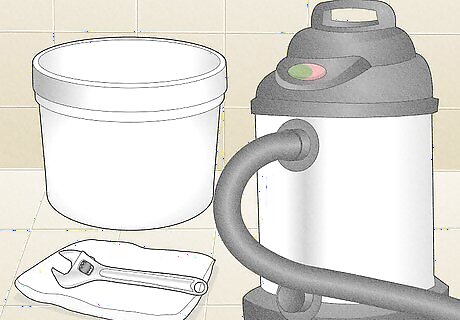
If you have a wet-dry vacuum, you can use it to suck drain clogs up. Remove the sink stopper from your sink. Turn the water on until it builds up a little in the sink. Wrap a rag around the hose on the wet-dry vac and stick it inside of the drain. Turn the vacuum on. Start at the lowest power level and slowly work your way up to the highest power. If the clog isn’t stuck to anything, your vacuum will pull it out! Do not do this immediately after you’ve used any chemicals or drain cleaners. You’ll end up sucking all kinds of chemicals up.
P-Trap Removal
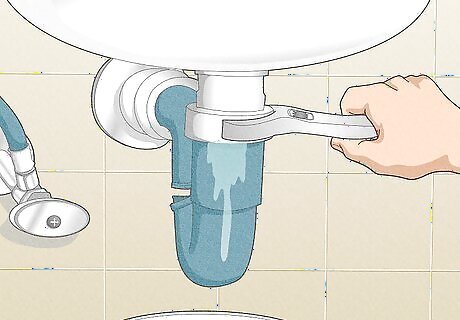
If all else fails, remove the pipe and clean it out by hand. Probably 80% of the time, the clog ends up in the P-trap. Set some towels and buckets out under the sink. Locate the nuts holding the round pipe (the P-trap) and use your hands or a wrench to twist them counterclockwise and unlock the pipe. Empty the water and use dish soap, water, a hose, or vinegar soak to break out whatever clogs are in there. Reassemble the P-trap when you’re done using the reverse steps you used to remove it. The P-trap is uses gravity to keep a little bit of water inside of the pipes so that weird odors don’t come out of the sink. As a byproduct of that, stuff tends to get stuck in there.




















Comments
0 comment